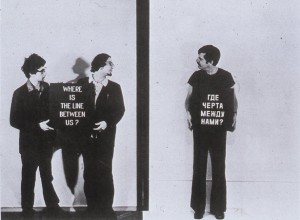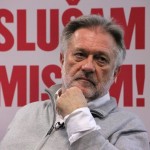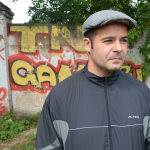
Note from the LeftEast editors: “Where is the line between us?: cautionary tales from now” was the title of the 3rd Garage international conference which brought to Moscow practitioners and thinkers from the fields of art, history, and sociology to examine the evolving positions toward the East/West axis in a post-socialist world. The speakers revisited selected regional histories since 1989 to show how our understanding of the past can change and develop through the lens of present circumstances, and vice versa. LeftEast’s Ilya Budraitskis interviewed one of the speakers: Rastko Močnik, sociologist, literary theorist, and Professor of Sociology at the University of Ljubljana.
Ilya Budraitskis: There is a Cold War type of confrontation between Russia and Eastern Europe. But there are also parallels, or similarities between the Eastern European countries and the socio-political situation in Russia. Would you agree that despite the temporary line of confrontation, there is a kind of common future, common destiny that is uniting the region, which includes Russia and Eastern Europe?
Rastko Močnik: Politically speaking, you are definitely right. The structure of political systems and the way in which they operate is not very different across the post-socialist countries. Even though there are specific traditions in politics, the present disappearance of real politics, and the homogenization on conservative liberal positions is actually spread even towards the former West, into Western Europe.
In terms of the social structures, I would say that Russia and the other post-socialist countries share the same silhouette, which basically means a struggle for national wealth that reproduces national economies. If we dig deeper into this social structure, then I would say that the former core countries from Western Europe are actually moving towards this periphery with their pauperized working class and a very tiny group of social managers, which are managing societies in the interest of a transnational global capital.
I would still say that this might be related to the new confrontation, and Russia is specific in a certain sense. For one, it is an enormous state. The next thing is related to my impression that Russia has a very strong bureaucratic tradition, with established administrative structures. One of the ways to understand Stalinism is to look at how the Tsarist administrative structures were reconstructed with the help of communist party leaders or cadres. Russia as an administrative structure and as an enormous geo-political entity has been much more resistant to the new colonization which has been promoted by the formerly dominant imperialist powers such as those in Western Europe, Great Britain and the United States. I guess that the current confrontation is the result of Russia not having become a new colony. Russia’s political groups are not comprador groups. Russia has its own – it is difficult to say capital elites because these are not productive capitalists – but rather a new elite of owners, who are resistant to this post-colonial imperialism.
For instance, it was easy to take Hungary as an example, because there the bureaucracy was dependent even before, and they just turned towards their new masters. In Yugoslavia it was different: its constituent units had their own administrative and political structure, and it had to be destroyed by force by making the little party state elites national. In post-Soviet Russia this has proven to be impossible. During Yeltsin’s times there were trends towards the colonization of Russia, when there were attempts at creating several dependent entities on the territory of the Russian Federation. This failed.
Ukraine and the ‘US attempts to handicap the EU’
The new complication is a bizarre byproduct of the disorientation of European Union and the panicking of the United States. The USA is always trying to handicap the EU. The exchange between the EU and US, or the NAFTA region, makes the West still the most powerful region in the world. In addition, of course, much of the capital that is sucked out of the periphery gets accumulating in Western Europe. The United States are trying in different ways to weaken the European Union. I think that what was happening in Ukraine was a result of this: the creation of tensions and conflicts in the recent EU automatically weakens Europe. At the same time, Europe doesn’t have a foreign policy. Europe doesn’t even have an authentic geostrategy. Nowadays, following the ideological defeat of liberalism, the European ruling classes do not really have popular support. They are disoriented and my impression is that the present Ukrainian crisis was created more by the European Union than by anybody else. EU was pushing the leadership in Ukraine towards an exclusive dilemma – either Russia will colonize it as a dependent state or the EU will do the same. They entered the mass revolt very early on trying to channel it towards a European democracy, pro-European politics, etc. And they didn’t have a strategy.
I.B.: I want to go a bit into the Yugoslavian question. I know that you were one of the very few intellectuals in Slovenia, who was standing in the beginning of 1990th for the unity of Yugoslavia. Your position was based also on the idea that Yugoslav unity was a kind of multi-national project that can prevent a society from an archaization and the rise of brutal nationalism. However, it was that model of the multi-national society which gave space for the rise to nationalism?
R.M.: The federation was based on proletarian internationalism, which united also other popular masses in an anti-fascist struggle. Yugoslavia as a socialist federation was created through the anti-fascist struggle, which at the same time had strong anticolonial elements. All of Yugoslavia was a periphery of some Imperial Structure – be it Habsburg, be it Ottoman. For me it represented a historical achievement. The prospect of disintegration until it started was beyond my horizon of thinking. Especially because separatist ideas in Slovenia were very marginal, they seemed more like coffee talks. In Croatia of course these separatist feelings or politics were stronger. But the Yugoslav idea actually originated in Croatia, in Croatia under Hungary, in the dualist monarchy. And of course we all knew that Bosnia, Macedonia and Montenegro really could not survive without Yugoslavia. When the disintegration started, my argument was that even if you took the Slovenian egotistical national interest in mind there was still a huge benefit for Slovenia to remain part of Yugoslavia: they had a monopolistic access to a 20 million market. In addition, helping the underdeveloped Yugoslavian regions was beneficial as it meant developing a market for Slovenian products. And indeed Slovenia was incredibly strong economically within Yugoslavia.
But on the other hand if you look at the differences between Slovenia and Kosovo, which was the most underdeveloped region, after WWII in 1946-47, Slovenia was 50% more developed in terms of GDP. In the 1980s, the divergence surged to around 400%. Even within the socialist federation there was a trend whereby the richer became richer and poorer became poorer, in spite of this being a permanent concern of federal politics.
Fragmentation of the Yugoslav party state bureaucracy and rise of nationalism
On the other hand, the party state bureaucracy within Yugoslavia had been fragmented along republican lines from very early on. Usually people say that the constitution of 1974 created a confederation and sanctioned the nationalist composition of the communist party, but this was only the end result of a process that can be traced back to the 1960s. In the beginning of the 1960s there was the first attempt at liberal reforms, which failed, and then the national reflexes were on the rise. The highest development rates in Yugoslavia were in the end of the 1950s, when the system was a mix of self-management and party control. And probably that was the best formula for an underdeveloped country in development. At that moment, between 1956 and 1960, Yugoslavia was doing better than Japan. Even the new reproduced value was very high, and the productivity of labor was high.

Then there was an attempt at liberal reforms in the beginning of the 1960s, which failed. It was probably at that time that they tried to “culture” an ideological bureaucracy, which was always nationalist. This was the case in Slovenia in particular because of the composition of the Anti-fascist Front, of the Front of National Liberation. When the economy started to shake and keeping the support of the masses became a challenge they started to make coalitions with the nationalists. Of course for a long time the communist or socialist ideology was hegemonizing, and could translate this trend into a kind of national liberation ideal. But then in the 1970s this ideology really started to turn to the right. The nationalist student movement was a Croatian invention in 1971-72.
Self-management
Self-management was doing better in public services than in the factories, because in the factories the management was afraid of the workers, but was nevertheless ultimately capable to manipulate them: with numbers, with a managerial discourse, etc. You had delegations: a delegation of people who worked in health or education, a delegation of people who consumed it, and this was all represented by the territorial unit. So there was a kind of negotiation going on, and the territorial unit was also financing the schools on its territory. The taxes were collected on the commune level, and many taxes were assigned on referendum. So it was a very flexible tax system. Not a lot of taxes were going to the republican level, and the federation got contributions from the republics on the grounds of supporting underdevelopment.
The whole system was projected downwards towards the republics, while the political guys already started to think nationally. In the late 60s the fragmentation began. The social democratic state was first liquidated in the core countries. And then it spread, first in capitalism, then it was communism or socialism. The liberal aggression was offensively strong. In Yugoslavia it came through the programs of the International Monetary Fund because Yugoslavia was indebted. The IMF wanted privatization, well – capitalism, free market, as they said. So they didn’t have to change much, they only changed the jargon.
I.B: My next question is about your perspective on the left in Slovenia and generally in former Yugoslavia. Last year there was the popular uprising in Bosnia, which gave the impression that it was not only against social injustice but also against nationalist sectarianism. What is your analysis of it, and the possibility of the left succeeding in former Yugoslavia, especially in light of the recent impressive results of the United Left in Slovenia?
R.M: Well, I’m close to the new ‘United Left’ as they are called in Slovenia, and I am especially close to one fraction of it – ‘The Initiative for Democratic Socialism’, which is probably the most solid nucleus of this coalition. Our problem is that we got into Parliament without having established and organization on the ground. The parliamentary operations are very absorbing. That’s the old problem. Left parties of course enter Parliament but it’s not their main battlefield, its main worksheet is to be among the masses. And now most of these United Leftists are absorbed into parliamentary intrigues. Entering Parliament has therefore been a mixed blessing. Yet, it gave legitimacy to opening up the left positions, the anti-capitalist positions.
My impression is that the Bosnian revolt was much more important and we should consider it an achievement. It was a proletarian uprising, it was violent at that moment, and it had a class perspective, which was much more pronounced than what you can demonstrate in parliamentary dealings where you have partial issues. In Croatia there’s a rather strong left movement here and there, and maybe they will present themselves as a party soon. They are stronger on the ground but also Croatia is a much bigger country than Slovenia, so it’s difficult to organize something in Croatia. In Serbia traditionally the left is fragmented from anarchists to Stalinists, and they are all intellectually very strong but I don’t know about their operational capacity. Sometimes it seems that they are really good and that there is a strong student movement. For instance, maybe Vojvodina is a region where a stronger left movement will start. As I said, working among the masses is a basic thing.
On the other hand, the Slovenian specificity was in the strong trade unions. Trade unions are in decline everywhere, and this worries me very much. You know, party activists are special people, and most people don’t enter parties. And trade unions are different things, they can be a very important background for a mass movement, and they are losing participation because the organization, ‘Pergam’, is Fordist, it is linked to full employment. And they are losing people when people lose jobs, trade unions lose contact with them, and of course they don’t pay membership, etc. But on the other hand, trade unions survived everywhere: they are strong in Croatia, they are strong in Slovenia, and they may become stronger in Serbia. Generally speaking, I’m optimistic because there’re no so many alternatives for the future.
 Rastko Močnik is a Slovenian sociologist, literary theorist, translator and political activist. He is professor of sociology at the Faculty of Arts of the University of Ljubljana. Močnik writes weekly columns in the Slovene leftist journal Mladina and is a member of the Advisory Board of the regional left-wing magazine Novi Plamen”.
Rastko Močnik is a Slovenian sociologist, literary theorist, translator and political activist. He is professor of sociology at the Faculty of Arts of the University of Ljubljana. Močnik writes weekly columns in the Slovene leftist journal Mladina and is a member of the Advisory Board of the regional left-wing magazine Novi Plamen”.
 Ilya Budraitskis is Moscow-based historian and political writer. He is current member of editorial board of Openleft.ru and Moscow Art Magazine.
Ilya Budraitskis is Moscow-based historian and political writer. He is current member of editorial board of Openleft.ru and Moscow Art Magazine.

